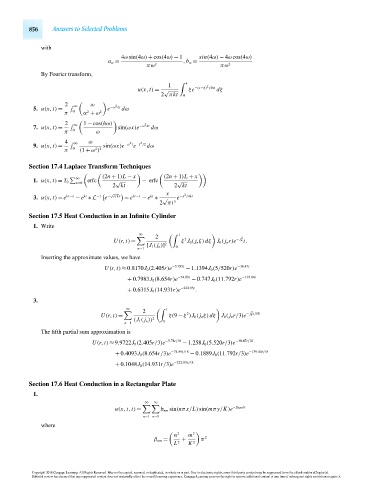Page 876 - Advanced_Engineering_Mathematics o'neil
P. 876
856 Answers to Selected Problems
with
4ω sin(4ω) + cos(4ω) − 1 sin(4ω) − 4ω cos(4ω)
a ω = ,b ω =
πω 2 πω 2
By Fourier transform,
1 4
u(x,t) = √ ξe −(x−ξ) 2 /4kt dξ
2 πkt 0
ω
∞ −ω 2 kt
2
5. u(x,t) = e dω
π 0 α + ω 2
2
1 − cos(hω)
2 ∞ −ω 2 kt
7. u(x,t) = 0 sin(ωx)e dω
π ω
ω
∞ −ω 2 t −t 2 /2
4
9. u(x,t) = sin(ωx)e e dω
2 2
π 0 (1 + ω )
Section 17.4 Laplace Transform Techniques
(2n + 1)L − x (2n + 1)L + x
∞
1. u(x,t) = T 0 erfc √ − erfc √
n=0
2 kt 2 kt
√ x
kt
kt
3. u(x,t) = e kt−x − e ∗ L −1 e − s/kx = e kt−x − e ∗ √ e −x 2 /4kt
2 πt 3
Section 17.5 Heat Conduction in an Infinite Cylinder
1. Write
∞ 1
2
− j 2
2
U(r,t) = ξ J 0 ( j n ξ)dξ J 0 ( j n r)e n t.
[J 1 ( j n )] 2
n=1 0
Inserting the approximate values, we have
U(r,t) ≈0.8170J 0 (2.405r)e −5.785t − 1.1394J 0 (5/520r)e −30.47t
+ 0.7983J 0 (8.654r)e −74.89t − 0.747J 0 (11.792r)e −139.04t
+ 0.6315J 0 (14.931r)e −222.93t .
3.
∞ 1
2
2
n
U(r,t) = ξ(9 − ξ )J 0 ( j n ξ)dξ J 0 ( j n r/3)e − j 2 t/18
(J 1 ( j n )) 2
n=1 0
The fifth partial sum approximation is
U(r,t) ≈9.9722J 0 (2.405r/3)e −5.78t/18 − 1.258J 0 (5.520r/3)e −30.47t/18
+ 0.4093J 0 (8.654r/3)e −74.89t/18 − 0.1889J 0 (11.792r/3)e −139.04t/18
+ 0.1048J 0 (14.931r/3)e −222.93t/18
Section 17.6 Heat Conduction in a Rectangular Plate
1.
∞ ∞
u(x,t,t) = b nm sin(nπx/L)sin(mπy/K)e −β nm kt
n=1 n=1
where
n m
2 2
β nm = + π 2
L 2 K 2
Copyright 2010 Cengage Learning. All Rights Reserved. May not be copied, scanned, or duplicated, in whole or in part. Due to electronic rights, some third party content may be suppressed from the eBook and/or eChapter(s).
Editorial review has deemed that any suppressed content does not materially affect the overall learning experience. Cengage Learning reserves the right to remove additional content at any time if subsequent rights restrictions require it.
October 14, 2010 17:50 THM/NEIL Page-856 27410_25_Ans_p801-866

